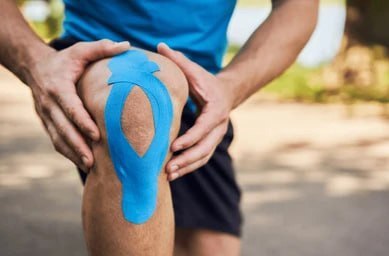Kinesiology Tape: Uses and Benefits

Related products
Rooted in the Greek terms kinesis (meaning movement) and logia (referring to study), Kinesiology encompasses a scientific field exploring movements executed by humans and non-humans. As an integral part of this domain, kinesiology tape—usually noted for its vibrant colours—has gained monumental popularity over the past four decades. Formulated originally by Dr Kenso Kase, it's highly favoured amongst athletes as well as those seeking natural alternatives to alleviating injury-related pain or amplifying physical performance capabilities.
Kinesiology tape is prominent across multiple sports disciplines. It is primarily designed to mimic the skin's elasticity so as not to restrict the range of motion yet provide therapeutic benefits—such as pain reduction, support during injury recovery, and improved circulation around swollen areas.
Doctors like physiotherapist David Colvin highlight its major role when he says, "It provides sensory stimulation which either facilitates or inhibits muscle function"." Medical professionals frequently affirm the significance of the neuromuscular response elicited by taping, which minimises discomfort while enhancing overall physical aptitude.
A review published in the British Journal of Sports Medicine observed significant improvement pertaining to proprioception (body position awareness sense ) post application compared against controls. Many researchers share consensus regarding the potential roles these tapes play towards augmenting athletic performances over traditional counterparts owing to features promoting freedom movement keeping protective capabilities intact.
In essence, various testimonies combined alongside intriguing evidence suggest promising aspects related to the usage of kinesiological tape transcending mere makeshift solution injuries and extending deeper into the realm of physiological optimisation endeavours.
What is Kinesiology Tape?

Nearly four decades ago, Dr. Kenso Kase unveiled kinesiology tape as a therapeutic innovation. Its primary function is to bolster the human body's inherent healing capabilities while simultaneously ensuring stability and support for muscles and joints—all without inhibiting freedom of movement.
Made of elastic cotton strip-backed adhesive, it mimics skin elasticity, enabling unrestricted bodily movement during physical activities. Unlike traditional tapes that bind restricted movements, this versatile clinical aid was conceived with free motion in mind and the continual delivery of therapeutic benefits.
It works on interfaces between the skin, circulatory system (blood lymph), nervous system, and muscular structures below. It affects host physiological effects, pain relief, improved circulation proprioception enhancement, and optimal postural alignment. When applied accurately, the patient experiences minimised discomfort and enhanced performance capacities due to neuromuscular responses elicited by taping.
Beyond athletics, where it is mostly visible offering injury prevention management advantages, it holds significant promise within the wider medical arena, especially in areas rehabilitating chronic musculoskeletal conditions, aiding postoperative recovery procedures, helping manage a variety of neurological complaints, improving functional living capabilities, and making tangible positive differences in the well-being of physically challenged individuals alike.
Compelling studies continue to evolve and substantiate many claimed positives, underscoring their relevance and potential to revolutionise non-invasive drug-free treatment modalities and the ever-evolving healthcare narrative today globally.
Benefits of Kinesiology Tape
Injury Relief
Kinesiology tape assists significantly in alleviating pain associated with injuries, especially those involving muscles and joints. It facilitates skin elevation away from sore tissues, enabling better blood flow and lymphatic drainage, ultimately catalysing the recovery process.
Circulation Enhancement
Strategic positioning of kinesiology tape boosts circulation around swollen or bruised areas by efficiently deflecting pressure off inflamed regions while promoting a healthier exchange of blood/lymph fluids.
Support & Stability Provision
The unique feature inherent in the design allows it to serve as a support mechanism for weak or injured body parts without imposing constraints on range-of-motion—unlike conventional athletic tapes.
Performance Improvement
Used extensively within sporting domains – helps stimulate muscle activation, thereby contributing towards increased strength endurance; attributes highly sought after athletes desiring get notch higher respective sports
Proprioception Augmentation
The Body's sense position space termed proprioception which, when enhanced, improves one's coordination precision during physical activities; kinesiology taping is reputed to improve upon dimension offering preventive, protective roles against potential injuries
Postoperative Rehabilitation Aid
Post-surgical remedial measures often incorporate the use of these tapes since they help manage swelling inflammation besides facilitating motor re-education, thus expediting return functionality to pre-injury levels earlier and faster manner, ensuring comfort eases patients forefront of all treatment goals.
Correction Posture Alignment issues
Improper posture alignment over time manifests host musculoskeletal problems. Through strategic placement across back shoulders, reinforcement of correct posture is subtly encouraged, prompting the spine to retain its natural curvature, eventually paving the way to mitigating prospects of chronic pains and dysfunctions downline.
Informed usage of kinesiological tape offers an array of benefits transcending age fitness levels—from elite athletes to elderly individuals physically challenged alike; thus, it stands testimony to universal acceptance worldwide in health wellness circles today.
How Does Kinesiology Tape Work?

Implementing basic principles from kinesiology, the tape functions by interacting with skin and muscles. Its main mechanism of action involves lifting the epidermis (skin) subtly to create a small space between the muscle and dermis layers. That extra space takes the pressure off swelling or injured tissues that might otherwise be compressed beneath the weight of one's own bodily fluids, enhancing circulation and promoting faster healing.
Additionally, it stimulates nerve receptors within the body, alerting the brain about specific areas needing attention. Thus, it amplifies natural protective reaction mechanisms inherent within, effectively reducing sensations related to pain and discomfort.
Perhaps the most fascinating aspect is how taping facilitates enhancement proprioception – almost like the sixth sense where individuals become more aware of their body's position in space. This leads to automatic corrective actions whenever movements deviate from intended patterns, resulting in a degree of precision and accuracy in physical activities, shifting the injury prevention paradigm to a proactive front.
Another intriguing feature is the ability to retrain the neuromuscular system, especially when dealing with chronic conditions. This helps patients regain lost functionalities over time and develop stronger resistance against recurrences of a similar nature in the future.
Kinesiological taping, therefore, goes beyond mere symptomatic relief, progressively steering towards comprehensive solutions addressing root cause issues. It aims to restore innate harmony and balance different physiological systems, thereby contributing to the overall well-being of fitness users.
How To Apply Kinesiology Tape
Applying kinesiology tape involves specific steps, each integral to the overall effectiveness of this therapeutic aid. Following a prescribed method ensures that maximum benefits are reaped from its usage.
- Skin Preparation—Before applying, it is crucial to clean and dry the skin area where installation is intended without oils, creams, or sweat residues affecting adhesive stickiness. Shaving hair from the application surface might ease removal later, reducing uncomfortableness stemming from pulling hairs.
- Measure Cut Tape Appropriately: Measure the required length with slight overestimation and allow tension adjustments; cut rounded corners to prevent peeling ends after placement
- Anchor Ends: Important both ends secured firmly onto the skin devoid of stretch, preventing irritation and early peel-offs
- Apply With Stretch – While the body part being taped needs to be put into a stretched position, actual taping must happen to maintain optimal level tension, typically falling between 15-25% of the total tape's capacity to avoid undue stress structures underneath; hence professional advice becomes pivotal during step
- Rub To Activate Adhesive Once applied, giving a firm rub along the entire strip activates heat-sensitive glue, ensuring a secure bond, thereby lasting longer
- Wait before engaging in activity. Wetness, including sweating and showering, is ideally avoided an hour post-application. Let adhere well set in
Given the variety of techniques available to target purposes and conditions, proper training supervision recommends preventing inappropriate use and risks related to misuse since reputations are important nuances within methodology essential, and all-optimising gains each step of using revolutionary healthcare tools off tools mankind today.
How To Remove Kinesiology Tape
Removing kinesiology tape requires a careful approach to avoid untoward skin irritation or damage. Here's the advisable method:
Begin peeling from either end, proceeding slowly in the opposite direction instead of ripping off quickly in one swift motion, which might stress and irritate fragile skin.
While doing so, apply light pressure with the other hand directly over the area where separation occurs for gentle easing out rather than forceful tugging.
Consider employing moisturiser oils like baby oil and coconut oil that assist in loosening adhesive properties, enabling easier removal.
For those experiencing discomfort during the process due to sensitive skin types, applying heat using a low and warm blow dryer setting just prior helps soften the glue, aiding smoother extraction.
To finish up, clean the site with mild soap water to remove residual stickiness, followed by thorough drying
A final point – resist temptation, peel straight upwards away the body. Instead, aim to roll forward along the contour skin's surface, maintaining a manageable flat angle throughout, minimising potential pulling and hurting unnecessarily.
Thus, adopting a patient, systematic technique while detaching ensures minimal risk-associated problems, ensuring a healthier, happier experience for users overall.
When Not To Tape
- Open wounds or Infection: Kinesiology tape must be avoided over areas with open sores, abrasions and infections owing to the potential risk of exacerbating the condition.
- Deep Vein Thrombosis (DVT): Individuals diagnosed with DVT, a serious medical condition involving blood clot formation in deep veins, ought not to use kinesiological tapes given the possibility of unintended dislodgement clots causing life-threatening complications.
- Allergic Reactions: Those known allergies sensitivity to adhesives should refrain as they trigger skin irritation and other allergic responses. Hypoallergenic variants might prove safer alternatives, such as cases requiring professional advice before application
- Severe Swelling/Inflammation Acute Injury Sites: Immediate aftermath sustaining acute injuries – especially severe swelling inflammation present -not ideal times for taping; seeking urgent emergency consultation takes precedence over any self-help measures at this stage
- Cancer Patients: As a precautionary measure, is typically discouraged amongst individuals suffering from cancer primarily due to lymphatic system involvement where altering the flow of fluids body carries risks of spreading the disease further
Remember, consulting a healthcare provider is essential before initiating do-it-yourself remedy options like kinesiology tape. Ensure appropriate indication, contraindication considerations, and safety efficacy every step of the way.
Bottomline
Kinesiology tape, an innovative therapeutic tool in sports and medicine, offers numerous benefits. Designed to mimic skin elasticity for unrestricted motion, it provides multifaceted uses that include injury relief by enhancing circulation around inflamed areas, improving performance through better muscle activation, and offering support and stability without limiting physical flexibility. Additionally, it is valuable as a postoperative rehabilitation adjunct or posture correction aid - its role is instrumental not only among athletes but also within diverse populations like physically challenged individuals or elderly patients. Kinesiology taping is gaining support from healthcare professionals worldwide, coupled with a growing body of scientific research. It is proving its credibility as an effective and noninvasive method for controlling pain. It continues to make influential progress in redefining prevailing paradigms within global health discourses.
Frequently Asked Question
What is the kinesiology tape good for?
Kinesiology tape is advantageous for injury relief, improved circulation around inflamed regions, and support and stability for injured or weak body parts without limiting the range of motion. Additionally, it enhances performance among athletes by promoting optimal muscle activation and proprioception.
When should you not use kinesiology tape?
Avoid applying kinesiology tape in cases of deep vein thrombosis (DVT), on open wounds/infected sites, or directly over acute injuries with severe inflammation/swelling without prior medical consultation; individuals allergic to the adhesive used might need to consider hypoallergenic variants.
What are the five main physiological effects of kinesio tape?
Five primary physiological effects include Pain alleviation via neurological suppression; microcirculation enhancement underneath the skin, improving blood lymph flow; structural benefit through postural alignment correction joint stabilisation; functional benefits such as better biomechanics during physical activities; and finally, improvement in fascia tissue movement; thus fostering overall bodily function optimisation.
What are the benefits of tape?
Tape generally offers numerous benefits, like supporting joints and muscles, preventing further injury, and aiding quick recovery. For sports people, it assists in fine-tuning motor control skills and enhancing muscular endurance, thereby positively impacting performance outcomes.
What are the disadvantages of kinesiology tape?
Disadvantages associated with kinesio taping involve potential skin irritation reactions against adhesives—especially those prone to allergies and sensitivities—coupled with some scepticism regarding effectiveness within the broader scientific community owing to insufficient evidence conclusively substantiating purported claims.
Can you wear kinesiology tape every day?
Wearing kinesiology tape every day isn't typically discouraged if tolerated well and not experienced any negative side effects, but context-dependent ideally, there needs to be an underlying rationale behind continuous usage. Professional guidance must always be sought to ensure appropriate indications and contraindications are carefully considered before embarking upon regular use.










 Rated Excellent by 26,523+ Reviews
Rated Excellent by 26,523+ Reviews